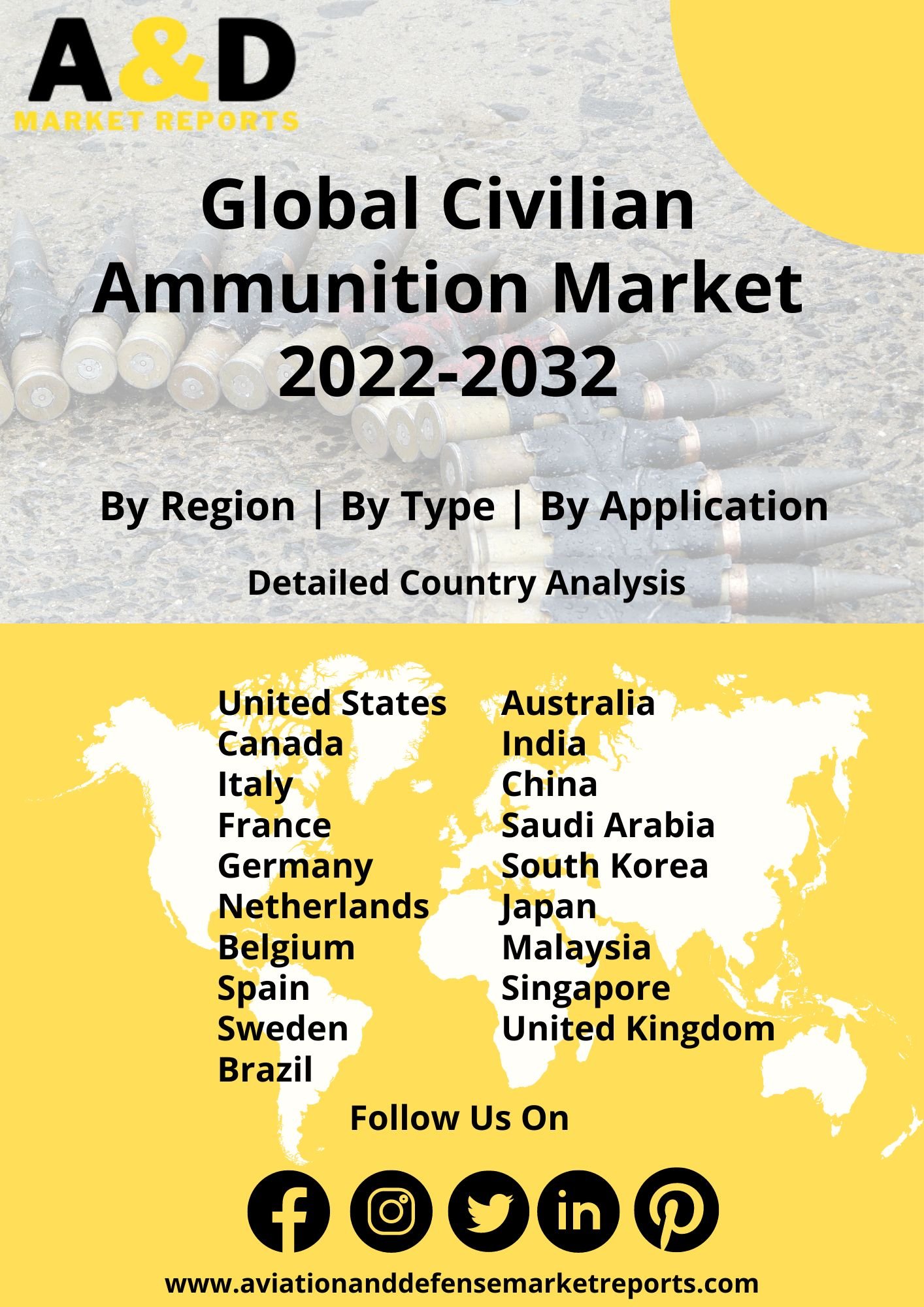Description
Civilian Ammunition Market
Ammunitions are quantified as firearms or projectiles that are propelled using weapon systems. Bombs, rockets, grenades, and land mines are examples of expendable weapons. Civilian ammunition market growth also refers to the individual elements of other weapons that can affect a target (e.g., bullets and warheads). The goal of civilian ammunition market trends is to exert force on a chosen target to produce an effect (usually, but not always, lethal). The firearm cartridge, which contains all the parts needed to deliver the weapon’s effect in a single package, is an example of ammunition.
Major Factors Driving Civilian Ammunition Market Growth
The United States, Yemen, and Iceland account for three of the key economies within the commercial ammunition market. Over 40 firearms are owned across these regions per 100 populations. The rate of civilian firearms holding was noted to be 120.5 in the US, 52.8 in Yemen, and 39.1 in Montenegro as well as Serbia. The sales of ammunition were impacted by the political unrest occurring throughout the world, particularly the alarming trend of coups in Africa. Concerns over the widespread distribution of small guns were rekindled after the Taliban overthrew Afghanistan’s Western-backed government and took control. Last but not least, Russia’s hostile stance toward Ukraine caused considerable anxiety, which regrettably turned out to be justified in early 2022.
Trends Influencing the civilian-ammunition Market Size
Studying the total amount of civilian ammunition market size sold on international marketplaces reveals that more unregistered firearms are in circulation than registered and licensed firearms. The main markets for the illicit trade in weapons are the US, India, China, and Russia. The growth in global crime rates is mostly to blame for the surge in the number of illegal firearms on the civilian market. This market’s expansion is likely to be constrained by the adoption of standards and the tightening of restrictions governing the possession of firearms. It is known that due to the greater risk to civilian safety, certain nations, like New Zealand, have banned semi-automatic firearms. One of the countries with severe gun control laws is reportedly Japan. Shotguns and air rifles are permitted to be owned in Japan, however, a civilian must pass many security checks to reach the same post.
Civilian-ammunition market forecast & dynamics
Studying the number of firearms bought in the US reveals that, in addition to pistols, assault rifles have the largest market share. Threatening civilian ammunition market forecast safety is the usage of assault rifles like the AK-47 and AR-15 in the civilian market. It is anticipated that incidents of friendly fire, misfires, and incorrect use of premium ammunition will increase the death toll in international markets. The United Nations claims that the armed forces currently have access to a surplus of weapons and ammunition. In addition, the proportion of lawful owners of firearms is significantly smaller than the proportion of illegal purchasers.
Studying the regional competitive mapping for the global market for civilian ammunition market report reveals that APAC is a promising region with the quickest growth rates. However, due to the presence of the US, North America is anticipated to be the largest market.
Civilian Ammunition Market Analysis for Recent Developments
According to civilian ammunition market analysis, because of the high crime rates in developing nations, both legal and unauthorized gun ownership is expected to rise. India expanded its domestic civilian market for Austrian Glock Pistols starting in 2021. Through a joint venture between Countermeasures Technologies Pvt. Ltd. (CMT), based in Tamil Nadu, and Glock Ges.m.b.H, Austria, the nation intends to increase its domestic production of Glock Pistols.
The initial goal of the joint company was to provide Glock pistols to the Indian government. However, the revised deal mandated that citizens receive the aforementioned product by the end of March 2021. To aid the Make in India movement, this effort was started. The Atmanirbhar Bharat movement is predicted to increase the number of indigenous programs in the country, improving employment prospects across India. The expansion of direct, indirect, and induced employment in India is expected to increase people’s ability to spend and their purchasing power.
Following a few years of scarcity, the majority of hunting calibers are finally accessible. However, conflicts could once more restrict resources. After three years of acute shortages of some of the most popular gauges and calibers, hunters throughout the Northland are starting to find much of the ammunition they need this fall. A significant rise in the ownership of new firearms, coupled with an untimely bankruptcy and factory closure, and supply chain constraints during the COVID-19 pandemic shutdown, have resulted in a significant decrease in availability in recent years, despite a rise in demand. As a result, there was little to no ammo available in numerous cases. Some hunters had to rely on borrowing, scrounging, or beg for ammunition for their preferred deer rifle or duck gun, while a number of customers hoarded anything they could find. Not only was ammunition more difficult to locate for a number of years, but as supply became scarcer, costs skyrocketed. Lacking essential parts, producers made do with what they had to produce their expensive, premium-brand cartridges, which may cost as much as $40 per box in certain situations.







